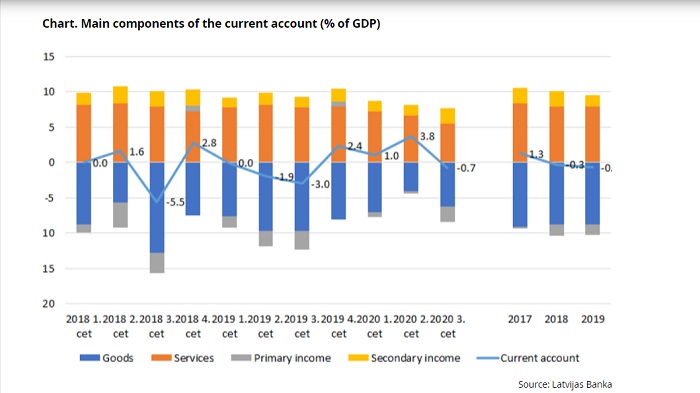Analytics, Banks, Direct Speech, Economics, Financial Services, Latvia
International Internet Magazine. Baltic States news & analytics
Thursday, 11.12.2025, 00:05
Balance of payments under the sign of COVID-19
 Print version
Print version |
|---|
However, with the number of new infections rising and restrictions tightening once again, the cross-border economic activity is expected to moderate to some extent.

While during the economic downturn foreign trade was affected more severely than the overall economy, in the third quarter it recorded a stronger recovery. Despite the fact that the economic situation remained difficult, exports of goods expanded markedly compared to the respective quarter of the previous year and even exceeded the volume of the first nine months of 2019.
It should be noted that Latvia's main trade partners have weathered the crisis relatively well. Moreover, during the pandemic Latvia enjoyed resilient demand for its exports, rich in agricultural, wood and food products. In this regard, the significant export performance of cereals should be highlighted: at the beginning of the export season in September, their export value reached a monthly high.
However, exports overall declined year-on-year in the third quarter on account of the weak performance of the more severely affected cross-border services. With various mobility restrictions still in place and people remaining cautious with respect to private and business trips, exports of travel services, the worst-affected sector, improved only slightly reaching merely 40% of the export value recorded in the third quarter of the previous year. Against the background of the low travel activity, the recovery of air passenger transport services was hampered in the third quarter which is typically the most active commercial period for the sector. Thus, the export performance of the entire transport services sector was affected negatively. The overall contraction in economic activity was also detrimental to the development of road transport services and transit-related transport services by sea and rail, with the sectors recording negative results already since the beginning of the year.
During the pandemic, other services sectors such as business services and construction services were more resilient, and their performance even improved. However, these sectors could not offset the contraction in travel-related services. With the imports of goods recovering strongly from the deep fall experienced in the second quarter, the overall goods and services trade balance turned negative (–0.8% of GDP) and contributed to a current account balance deficit (–0.7% of GDP) in the third quarter.
The income account flows offset each other in the third quarter of 2020. The secondary income account recorded a surplus due to large personal transfer flows which exceeded those reported for the corresponding period of the previous year. Meanwhile, the primary income balance shrank quarter-on-quarter. With foreign investors typically reporting a large part of their profits in the third quarter, these profits only slightly lagged behind those reported for the respective period of the previous year, suggesting that the impact of the pandemic on the profitability of foreign businesses operating in Latvia has been limited.
In the third quarter, the largest flows in the financial account were related to the investment of funds of Latvian commercial banks in foreign securities and the participation of Latvijas Banka in Eurosystem monetary policy operations. With reinvested earnings recovering, inflows of direct investment in Latvia continued (3.2% of GDP).
- 28.01.2022 BONO aims at a billion!
- 25.01.2021 Как банкиры 90-х делили «золотую милю» в Юрмале
- 30.12.2020 Накануне 25-летия Балтийский курс/The Baltic Course уходит с рынка деловых СМИ
- 30.12.2020 On the verge of its 25th anniversary, The Baltic Course leaves business media market
- 30.12.2020 Business Education Plus предлагает анонсы бизнес-обучений в январе-феврале 2021 года
- 30.12.2020 Hotels showing strong interest in providing self-isolation service
- 29.12.2020 В Латвии вводят комендантский час, ЧС продлена до 7 февраля
- 29.12.2020 В Rietumu и в этот раз создали особые праздничные открытки и календари 2021
- 29.12.2020 Latvia to impose curfew, state of emergency to be extended until February 7
- 29.12.2020 18-19 января Наталия Сафонова проводит семинар "Управленческий учет во власти собственника"








 «The Baltic Course» Is Sold and Stays in Business!
«The Baltic Course» Is Sold and Stays in Business!

